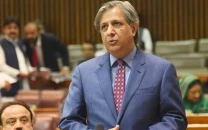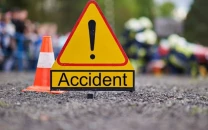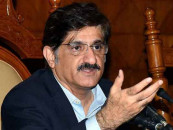Benazir’s murder and Musharraf
Benazir named the persons she thought would conspire to kill her including Hameed Gul and Chaudhry Pervaiz Elahi.

After Benazir Bhutto’s assassination, the PPP began saying that its leader was killed as a result of an international conspiracy. Succumbing to oriental conspiracy theories, it got a reluctant UN involved in the investigation. In so doing, it took the focus away from the men — who had trained at a seminary in Nowshehra — arrested for Benazir’s assassination in Rawalpindi. Then the UN delivered its verdict, expressing its disapproval over the way the army had behaved after the murder. The PPP then tried to get the UN to retract, but the UN refused to do so, after which the PPP disowned the UN report.
Journalist Amir Mir has published his book The Bhutto Murder Trail: From Waziristan to GHQ (Tranquebar, India, 2010), based on his interviews with Benazir. This was the time when she thought she was going to be killed and was sure, if she died, that Musharraf would have a hand in it. She told him: “I cannot give you any more details at the moment. You can however name Musharraf as my assassin if I am killed” (p.31).
She had ‘inside information’ about who would kill her. She disclosed it to Musharraf in a letter. About one of them, Abdul Rehman Sindhi of al Qaeda, who tried to kill her at Karsaz in Karachi, she said that she had received information from the Karzai government. Sindhi was, she said, released from jail just before her arrival in Karachi. She also had information about a cell created by the ISI in a safe house in Islamabad to manipulate the 2008 elections, and the officers working in it included Brigadier (retd) Riazullah Khan Chib, and Intelligence Bureau director-general, Brigadier (retd) Ejaz Hussain Shah (p.42).
Author Amir Mir got her the lowdown on this Sindhi person from al Qaeda: He was a Lashkar-e-Jhangvi leader from Dadu and had a background in the Afghan jihad, rare for a Sindhi. Sindhi was linked to Abu Zubayda, one of the earliest al Qaeda agents arrested in Faisalabad. The book says: “The sources believe Abdul Rehman Sindhi had the approval of some highly-placed individuals with jihadi leanings in the Pakistani intelligence establishment, to carry out the bombing. Sindhi had finalised the October 18, 2007 Karachi bombing at his hideout in Karachi’s Gulistan-e-Johar locality” (p.40).
Benazir named the persons she thought would conspire to kill her and these included, ex-ISI boss, Hameed Gul — heading recalcitrant Islamists within the ISI — and Chaudhry Pervaiz Elahi — because Brigadiers Shah and Chib were close to the Chaudhrys (p.44). She linked Brigadier Shah to the murder of Daniel Pearl at the hands of al Qaeda leader Khalid Sheikh Muhammad, thus linking the ISI to al Qaeda.
But the UN Commission Report took serious note of Military Intelligence (MI) chief Major-General Nadeem Ijaz’s order to the police officer in charge of the scene of Benazir’s murder to wash the street where she had been killed. The book says: “In the light of the findings of the UN Commission’s inquiry report, the role of Nadeem Ijaz [a relative of Musharraf] emerged as one of the most controversial” (p.231). This meant that the army under Musharraf could have been involved, which made ex-foreign minister Shah Mehmood Qureshi write to the UN general secretary rejecting the linkage. The secretary general stood by the contents of the report.
The self-confessed killers under trial — Nasrullah, Qari Ismail, Ibadur Rehman, Hasnayn Gul and Muhammad Rafaqat — had stayed at Madrassa Haqqaniya in Nowshehra, the seminary where the Taliban got their tough Islamic education. The seminary wields more power than the PPP can tackle. Chaudhry Shujaat has already spoken to defend it against possible indictment. And the Rawalpindi court hearing the case might finally let the killers of Benazir go in the end.
Published in The Express Tribune, April 24th, 2011.
Journalist Amir Mir has published his book The Bhutto Murder Trail: From Waziristan to GHQ (Tranquebar, India, 2010), based on his interviews with Benazir. This was the time when she thought she was going to be killed and was sure, if she died, that Musharraf would have a hand in it. She told him: “I cannot give you any more details at the moment. You can however name Musharraf as my assassin if I am killed” (p.31).
She had ‘inside information’ about who would kill her. She disclosed it to Musharraf in a letter. About one of them, Abdul Rehman Sindhi of al Qaeda, who tried to kill her at Karsaz in Karachi, she said that she had received information from the Karzai government. Sindhi was, she said, released from jail just before her arrival in Karachi. She also had information about a cell created by the ISI in a safe house in Islamabad to manipulate the 2008 elections, and the officers working in it included Brigadier (retd) Riazullah Khan Chib, and Intelligence Bureau director-general, Brigadier (retd) Ejaz Hussain Shah (p.42).
Author Amir Mir got her the lowdown on this Sindhi person from al Qaeda: He was a Lashkar-e-Jhangvi leader from Dadu and had a background in the Afghan jihad, rare for a Sindhi. Sindhi was linked to Abu Zubayda, one of the earliest al Qaeda agents arrested in Faisalabad. The book says: “The sources believe Abdul Rehman Sindhi had the approval of some highly-placed individuals with jihadi leanings in the Pakistani intelligence establishment, to carry out the bombing. Sindhi had finalised the October 18, 2007 Karachi bombing at his hideout in Karachi’s Gulistan-e-Johar locality” (p.40).
Benazir named the persons she thought would conspire to kill her and these included, ex-ISI boss, Hameed Gul — heading recalcitrant Islamists within the ISI — and Chaudhry Pervaiz Elahi — because Brigadiers Shah and Chib were close to the Chaudhrys (p.44). She linked Brigadier Shah to the murder of Daniel Pearl at the hands of al Qaeda leader Khalid Sheikh Muhammad, thus linking the ISI to al Qaeda.
But the UN Commission Report took serious note of Military Intelligence (MI) chief Major-General Nadeem Ijaz’s order to the police officer in charge of the scene of Benazir’s murder to wash the street where she had been killed. The book says: “In the light of the findings of the UN Commission’s inquiry report, the role of Nadeem Ijaz [a relative of Musharraf] emerged as one of the most controversial” (p.231). This meant that the army under Musharraf could have been involved, which made ex-foreign minister Shah Mehmood Qureshi write to the UN general secretary rejecting the linkage. The secretary general stood by the contents of the report.
The self-confessed killers under trial — Nasrullah, Qari Ismail, Ibadur Rehman, Hasnayn Gul and Muhammad Rafaqat — had stayed at Madrassa Haqqaniya in Nowshehra, the seminary where the Taliban got their tough Islamic education. The seminary wields more power than the PPP can tackle. Chaudhry Shujaat has already spoken to defend it against possible indictment. And the Rawalpindi court hearing the case might finally let the killers of Benazir go in the end.
Published in The Express Tribune, April 24th, 2011.



















COMMENTS
Comments are moderated and generally will be posted if they are on-topic and not abusive.
For more information, please see our Comments FAQ